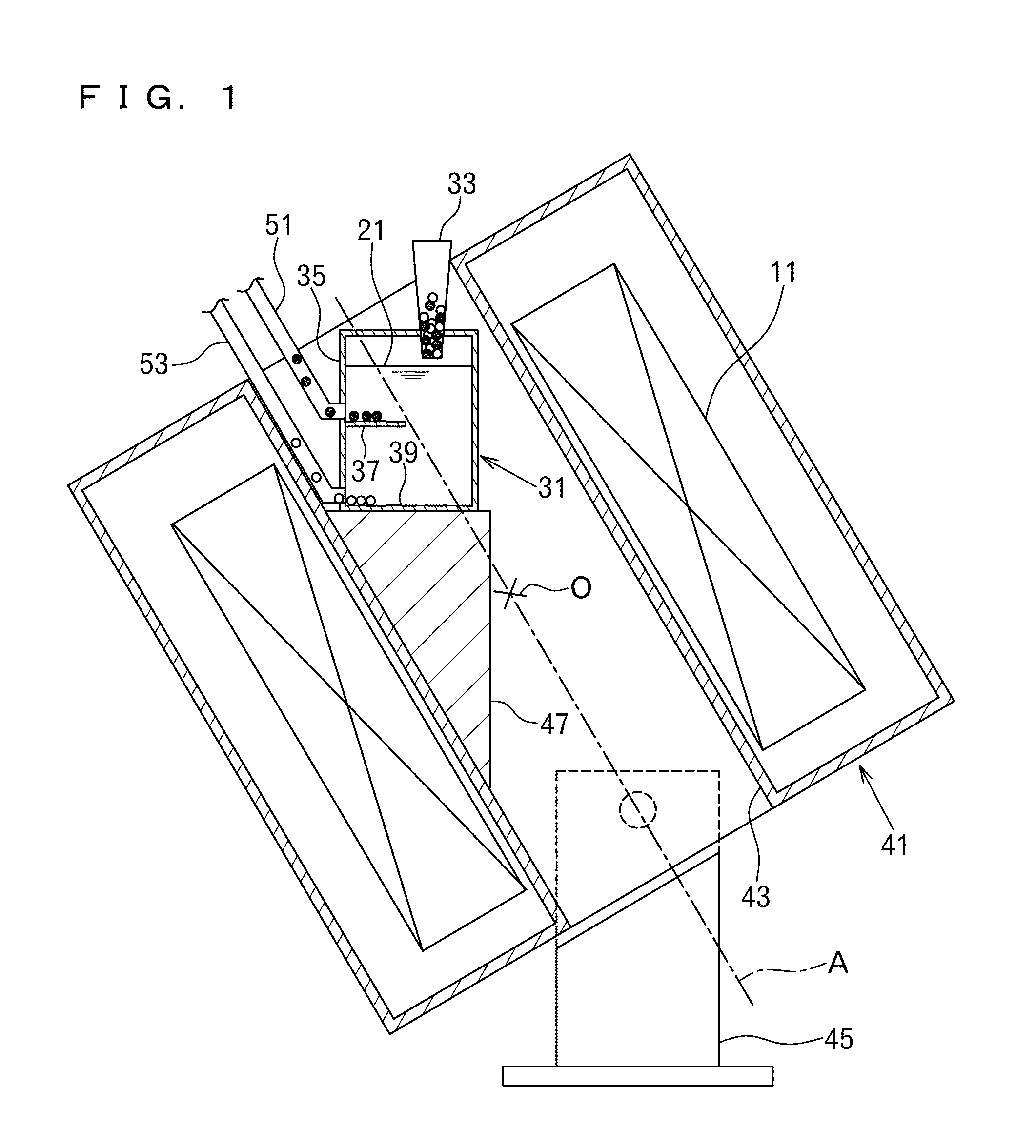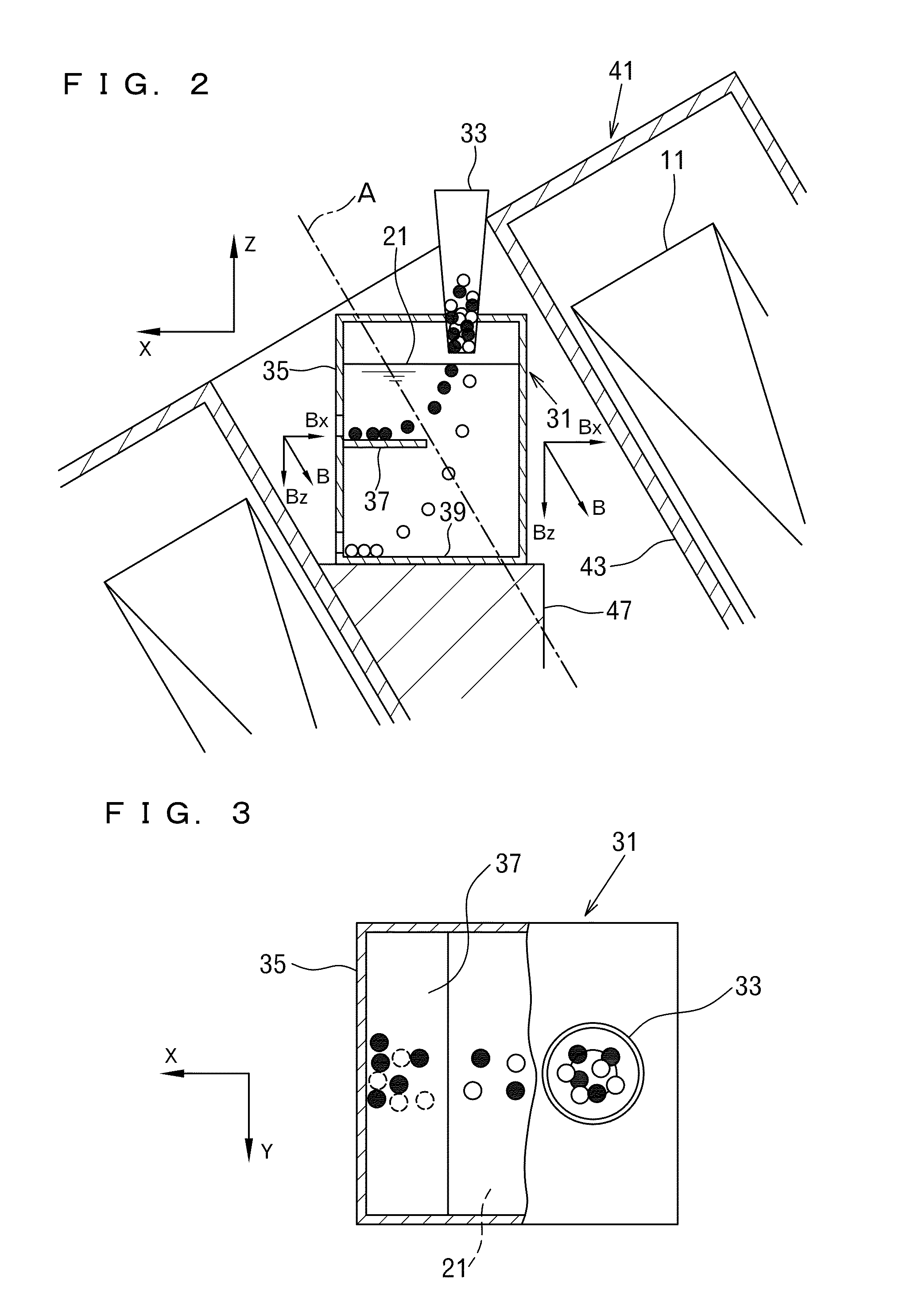Method and apparatus for separation of mixture
a technology of mixture and separation method, which is applied in the direction of magnetic separation, solid separation, chemistry apparatus and processes, etc., can solve the problems of large-scale system and complicated system that are necessary to realize this method, and achieve the effect of accurately separating a specific type of particle and accurately separating the mixture by typ
- Summary
- Abstract
- Description
- Claims
- Application Information
AI Technical Summary
Benefits of technology
Problems solved by technology
Method used
Image
Examples
example 1
[0072]A superconducting magnet using a solenoid coil having a bore size of 100 mm was disposed such that the coil central axis was inclined by 30 degrees with respect to the vertical direction. As shown in FIGS. 1 and 2, a separating tank storing a 50 wt % aqueous solution of manganese chloride as the supporting liquid was disposed in the internal space surrounded by the superconducting magnet. The separating tank was made of transparent carbonate, and had a shape as shown in FIGS. 1 to 3. The separating tank had a width of 40 mm, a length of 40 mm, and a height of 50 mm, and a shelf board having a width of 15 mm was provided so as to project at a height of 25 mm from the bottom face.
[0073]A mixture of glass (silica) particles (diamagnetic substance) and alumina particles (diamagnetic substance) was prepared (see Table 1 for the density and the volume susceptibility of the glass (silica) and the alumina), electricity was supplied to the superconducting magnet, so that a magnetic fie...
example 2
[0075]FIGS. 9(a) and 9(b) are explanatory views schematically illustrating the outline of Example 2 corresponding to the third embodiment described above. A separating tank (71) approximately in a U shape was manufactured from transparent carbonate. The separating tank (71) had a length of 70 mm, a height of 60 mm, and a width of 2 mm, and a horizontal shelf board (73) was provided at a height of 10 mm from the bottom face. Extending portions (75a) and (75b) at both ends of the separating tank (71) had open upper ends. One of the extending portions, i.e., the extending portion (75b), was provided with a vertical partition plate (77) that was linked to the shelf board (73). The separating tank (71) stored a 50 wt % aqueous solution of manganese chloride as a supporting liquid (79).
[0076]A mixture of aluminum particles (paramagnetic substance) and titanium particles (paramagnetic substance) was prepared (see Table 1 for the density and the volume susceptibility of the aluminum and the...
example 3
[0080]Treatment was performed as in Example 2, except that the mixture of glass particles and alumina particles of Example 1 was used, and that a 15 wt % aqueous solution of cobalt chloride was used as the supporting liquid (79). The glass particles and the alumina particles floated due to the magneto-Archimedes effect at mutually different heights as shown in FIG. 9(a), and then traveled in the horizontal direction (in the radial direction) while sinking in the supporting liquid (79) as shown in FIG. 9(b), after which the glass particles were positioned on the shelf board (73), and the alumina particles were positioned on the bottom face of the separating tank (71), as shown in the photograph in FIG. 12(a).
PUM
| Property | Measurement | Unit |
|---|---|---|
| density | aaaaa | aaaaa |
| volume susceptibility | aaaaa | aaaaa |
| magnetic field | aaaaa | aaaaa |
Abstract
Description
Claims
Application Information
 Login to View More
Login to View More - R&D
- Intellectual Property
- Life Sciences
- Materials
- Tech Scout
- Unparalleled Data Quality
- Higher Quality Content
- 60% Fewer Hallucinations
Browse by: Latest US Patents, China's latest patents, Technical Efficacy Thesaurus, Application Domain, Technology Topic, Popular Technical Reports.
© 2025 PatSnap. All rights reserved.Legal|Privacy policy|Modern Slavery Act Transparency Statement|Sitemap|About US| Contact US: help@patsnap.com



